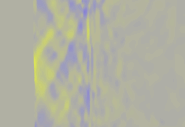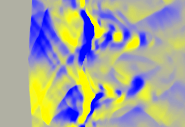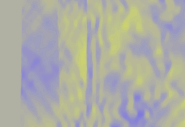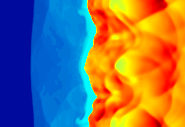2D Linear Perturbation
The response of a steady radiative shock to a linear perturbation
in 2D was investigated by dropping a small cloudlet into the
shock front. In this simulation the Mach number is 5 and the
cooling exponent alpha is 0. The perturbation excites the planar
oscillations of the shock front as expected from 1D analysis, but
it also excites non-planar oscillations in the cooling region.
Transverse Velocity showing the evolution of the non-planar mode.
The non-planar mode grows, peaks, and decays away. Gray in these images
represents zero transverse velocity, yellow is up, and blue is down.



 An mpeg movie of the transverse velocity
An mpeg movie of the transverse velocity
Density at the time of maximum amplitude of the non-planar oscillations.







 An mpeg movie of the transverse velocity
An mpeg movie of the transverse velocity